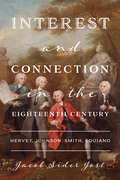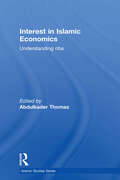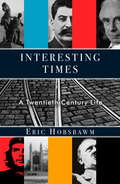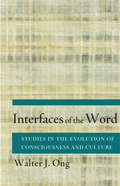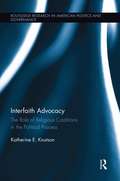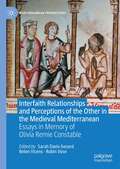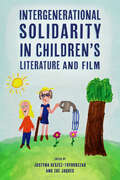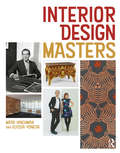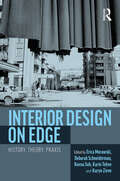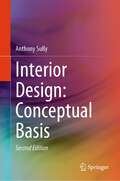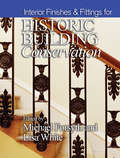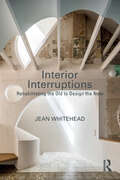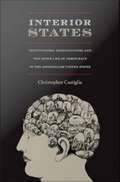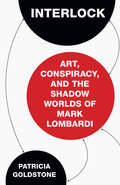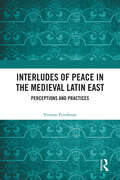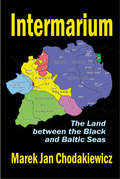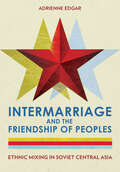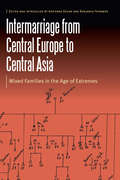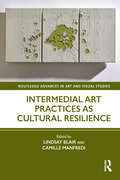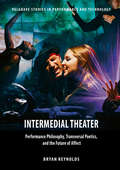- Table View
- List View
Interest and Connection in the Eighteenth Century: Hervey, Johnson, Smith, Equiano
by Jacob Sider JostCan a single word explain the world? In the British eighteenth century, interest comes close: it lies at the foundation of the period’s thinking about finance, economics, politics, psychology, and aesthetics. Interest and Connection in the Eighteenth Century provides the first comprehensive account of interest in an era when a growing national debt created a new class of rentiers who lived off of interest, the emerging discipline of economics made self-interest an axiom of human behavior, and booksellers began for the first time to market books by calling them "interesting." Sider Jost reveals how the multiple meanings of interest allowed writers to make connections—from witty puns to deep structural analogies—among different spheres of eighteenth-century life. Challenging a long and influential tradition that reads the eighteenth century in terms of individualism, atomization, abstraction, and the hegemony of market-based thinking, this innovative study emphasizes the importance of interest as an idiom for thinking about concrete social ties, at court and in families, universities, theaters, boroughs, churches, and beyond. To "be in the interest of" or "have an interest with" another was a crucial relationship, one that supplied metaphors and habits of thought across the culture. Interest and Connection in the Eighteenth Century recovers the small, densely networked world of Hanoverian Britain and its self-consciously inventive language for talking about human connection.
Interest in Islamic Economics: Understanding Riba (Routledge Islamic Studies Series)
by Abdulkader ThomasWith Islamic banking gradually becoming a more influential factor in the West, an analysis of the concept of riba – a definition of which is not given in the Qur’an – is long overdue. This text presents readers with various interpretations of this Islamic economic concept – generally perceived as ‘interest’. Thomas provides a framework for understanding riba by examining: linguistics classical judicial analysis the historical context modern economics. Including contributions from prominent international scholars, the book fills a gap in the existing literature and will be welcomed by academics and professionals with an interest in Islamic studies, economics and legal history.
Interesting Times: A Twentieth-century Life
by Eric HobsbawmEric Hobsbawm is considered by many to be our greatest living historian. Robert Heilbroner, writing about Hobsbawm's The Age of Extremes 1914-1991 said, "I know of no other account that sheds as much light on what is now behind us, and thereby casts so much illumination on our possible futures. " Skeptical, endlessly curious, and almost contemporary with the terrible "short century" which is the subject of Age of Extremes, his most widely read book, Hobsbawm has, for eighty-five years, been committed to understanding the "interesting times" through which he has lived. Hitler came to power as Hobsbawm was on his way home from school in Berlin, and the Soviet Union fell while he was giving a seminar in New York. He was a member of the Apostles at King's College, Cambridge, took E. M. Forster to hear Lenny Bruce, and demonstrated with Bertrand Russell against nuclear arms in Trafalgar Square. He translated for Che Guevara in Havana, had Christmas dinner with a Soviet master spy in Budapest and an evening at home with Mahalia Jackson in Chicago. He saw the body of Stalin, started the modern history of banditry and is probably the only Marxist asked to collaborate with the inventor of the Mars bar. Hobsbawm takes us from Britain to the countries and cultures of Europe, to America (which he appreciated first through movies and jazz), to Latin America, Chile, India and the Far East. With Interesting Times, we see the history of the twentieth century through the unforgiving eye of one of its most intensely engaged participants, the incisiveness of whose views we cannot afford to ignore in a world in which history has come to be increasingly forgotten. From the Hardcover edition.
Interests and Integration: Market Liberalization, Public Opinion, and European Union
by Matthew J. GabelIntegration in Europe has been a slow incremental process focusing largely on economic matters. Policy makers have tried to develop greater support for the European Union by such steps as creating pan-European political institutions. Yet significant opposition remains to policies such as the creation of a single currency. What explains continued support for the European Union as well as opposition among some to the loss of national control on some questions? Has the incremental process of integration and the development of institutions and symbols of a united Europe transformed public attitudes towards the European Union? In this book, Matthew Gabel probes the attitudes of the citizens of Europe toward the European Union. He argues that differences in attitudes toward integration are grounded in the different perceptions of how economic integration will affect individuals' economic welfare and how perceptions of economic welfare effect political attitudes. Basing his argument on Easton's idea that where affective support for institutions is low, citizens will base their support for institutions on their utilitarian appraisal of how well the institutions work for them, Gabel contends that in the European Union, citizens' appraisal of the impact of the Union on their individual welfare is crucial because their affective support is quite low. This book will be of interest to scholars studying European integration as well as scholars interested in the impact of public opinion on economic policymaking.
Interfaces of the Word: Studies in the Evolution of Consciousness and Culture
by Walter J. OngIn Interfaces of the World, Walter J. Ong explores the effects on consciousness of the word as it moves through oral to written to print and electronic culture.
Interfaith Advocacy: The Role of Religious Coalitions in the Political Process
by Katherine E. KnutsonUsing the historic Minnesota state government shutdown of 2011 as a backdrop, Interfaith Advocacy describes the work of the Joint Religious Legislative Coalition, an interfaith advocacy group that brings together leaders from Catholic, Protestant, Jewish, and Muslim traditions to advocate on behalf of a range of policies. As the nation's first statewide interfaith lobbying group, the story of the JRLC facilitates an examination of the role of political advocacy groups in state level American politics: what they are, how and why they form, how they mobilize citizens to participate in the political process, how they work to influence government, and what their impact is on American democracy. With research based on two years of in-depth interviews, participant observation, and analysis of archival records, this volume offers proof that it is possible to build successful long term political coalitions among improbable allies. The book investigates both the strengths and weaknesses of this model of advocacy and concludes that the presence of religious advocacy groups in the political process offers substantial benefits of representation, concern for underrepresented issues and groups, and the development of networks of social capital. Interfaith Advocacy is grounded in the theoretical literature of political science but also accessible to all readers who have an interest in political advocacy, state politics, or religion and politics.
Interfaith Relationships and Perceptions of the Other in the Medieval Mediterranean: Essays in Memory of Olivia Remie Constable (Mediterranean Perspectives)
by Sarah Davis-Secord Belen Vicens Robin VoseThis book is a collaborative contribution that expands our understanding of how interfaith relations, both real and imagined, developed across medieval Iberia and the Mediterranean. The volume pays homage to the late Olivia Remie Constable’s scholarship and presents innovative, thought-provoking, interdisciplinary investigations of cross-cultural exchange, ranging widely across time and geography. Divided into two parts, “Perceptions of the ‘Other’” and “Interfaith relations,” this volume features scholars engaging with church art, literature, historiography, scientific treatises, and polemics, in order to study how the religious “Other” was depicted to serve different purposes and audiences. There are also microhistories that examine the experiences of individual families, classes, and communities as they interacted with one another in their own specific contexts. Several of these studies draw their source material from church and state archives as well as jurisprudential texts, and span the centuries from the late medieval to early modern periods.
Interferon: The Science and Selling of a Miracle Drug (Routledge Studies in the History of Science, Technology and Medicine)
by Toine PietersThis innovative study charts the beginnings, history and fate of Interferon - one of modern medicine's most famous and infamous drugs. Interferon is part of the medical profession's armoury against viral infection, cancer and MS. The story of its development and use is one of survival in the face of remarkable cycles of promise and disappointment as a miracle drug. By telling this story, Toine Pieters' book provides insight into the research, manufacture, and marketing of new bio-molecules that mark modern medical science. Pieters' closely argued book adopts a multi-disciplinary approach in seeking to trace the extraordinary voyage of interferon. Through the lens of interferon's voyage, the book explores the interaction of the broad range of actors driving medical science: *biological and clinical researchers *the pharmaceutical industry *high-powered government agencies *doctors and patients *the media. The book demonstrates how research on interferon led to new clinical definitions of cancer and a new rationale for therapeutic use of the drug. Interferon provides a marvellous insight into the development of one of the most controversial drugs of our time. It enhances our understanding of how medicine manufacture and marketing all played a part in pushing back the boundaries of research, from the post-penicillin era to the genetics revolution in medicine. This study is of particular interest to undergraduates and postgraduates in the fields of History of Medicine, Pharmacology, Medical Genetics and History of Science.
Intergenerational Solidarity in Children’s Literature and Film (Children's Literature Association Series)
by Justyna Deszcz-Tryhubczak and Zoe JaquesWinner of the 2023 Edited Book Award from the International Research Society for Children's LiteratureContributions by Aneesh Barai, Clémentine Beauvais, Justyna Deszcz-Tryhubczak, Terri Doughty, Aneta Dybska, Blanka Grzegorczyk, Zoe Jaques, Vanessa Joosen, Maria Nikolajeva, Marek Oziewicz, Ashley N. Reese, Malini Roy, Sabine Steels, Lucy Stone, Björn Sundmark, Michelle Superle, Nozomi Uematsu, Anastasia Ulanowicz, Helma van Lierop-Debrauwer, and Jean Webb Intergenerational solidarity is a vital element of societal relationships that ensures survival of humanity. It connects generations, fostering transfer of common values, cumulative knowledge, experience, and culture essential to human development. In the face of global aging, changing family structures, family separations, economic insecurity, and political trends pitting young and old against each other, intergenerational solidarity is now, more than ever, a pressing need. Intergenerational Solidarity in Children’s Literature and Film argues that productions for young audiences can stimulate intellectual and emotional connections between generations by representing intergenerational solidarity. For example, one essayist focuses on Disney films, which have shown a long-time commitment to variously highlighting, and then conservatively healing, fissures between generations. However, Disney-Pixar’s Up and Coco instead portray intergenerational alliances—young collaborating with old, the living working alongside the dead—as necessary to achieving goals. The collection also testifies to the cultural, social, and political significance of children’s culture in the development of generational intelligence and empathy towards age-others and positions the field of children’s literature studies as a site of intergenerational solidarity, opening possibilities for a new socially consequential inquiry into the culture of childhood.
Interior Design Masters
by Mark Hinchman Elyssa YonedaInterior Design Masters contains 300 biographical entries of people who have significantly impacted design. They are the people, historical and contemporary, that students and practitioners should know. Coverage starts in the late Renaissance, with a focus on the twentieth and twenty-first centuries. The book has five sections, with the entries alphabetical in each, so it can serve as a history textbook and a reference guide. The seventeeth- and eighteenth-century section covers figures from Thomas Chippendale to Horace Walpole. The nineteenth-century section includes William Morris and Candace Wheeler. The early twentieth-century section presents modernism’s design heroes, including Marcel Breuer, Eileen Gray, and Gilbert Rohde. The post-World War II designers range from Madeleine Castaing to Raymond Loewy. The final contemporary section includes Ron Arad and the Bouroullec brothers. These are the canonical figures who belong to any design history. The book also contains less well-known figures who deserve attention, such as Betty Joel, the British art deco furniture designer; Paul Veysseyre, the Frenchman active in China in the 1930s; and more recently Lanzavecchia-Wai, the Italian-Singaporean duo whose work ranges from health care to helicopters. Global in its coverage, the book is richly illustrated with over 600 black-and-white and color photographs.
Interior Design on Edge: History, Theory, Praxis
by Deborah Schneiderman Keena Suh Karin Tehve Karyn Zieve Erica MorawskiInterior Design on Edge explores ways that interiors both constitute and upset our edges, whether physical, conceptual or psychological, imagined, implied, necessary or discriminatory.The essays in this volume explore these questions in history, theory, and praxis through a focus on different periods, cultures, and places. Interior Design on Edge showcases new scholarship that expands and contests traditional relationships between architecture, interiors, and the people that use and design them, provoking readers to consider the interior differently, moving beyond its traditional, architectural definition. Focusing on the concept of interiority considered in a wider sense, it draws on interdisciplinary modes of investigation and analysis and reflects the latest theoretical developments in the fields of interior design history and practice.With new research from both established and emerging authors, this volume will make a valuable contribution to the fields of Interior Design, Architecture, Art and Design History, Cultural History, Visual Culture Studies, and Urban Studies.
Interior Design: Conceptual Basis
by Anthony SullyThis book introduces interior design as a conceptual way of thinking, which is about ideas and how they are formulated. Now in its second edition, the book is enlarged to include topical subjects such as artificial intelligence, sustainability and climate change. The book prepares designers to focus on each concept independently as much as possible, whilst acknowledging relative connections without unwarranted influences unfairly dictating a conceptual bias, and is about that part of the design process called conceptual analysis. The major themes of this second edition of Interior Design: Conceptual Basis are the seven concepts of planning, circulation, 3D, construction, materials, colour and lighting, which cover the entire spectrum of a designer’s activity. It is assumed that the site, location, building and orientation as well as the client’s brief of activities and needs have been digested and analysed to provide the data upon which the design process can begin. Designed as a highly visual illustrative book, as the interior design medium demands, the hands-on creative process of designing is detailed with original drawn illustrations. Concentrating on the conceptual process of designing interiors, and defining what these concepts are, this book helps the designer to organise his/her process of designing and to sharpen the links between the various skill bases necessary to do the job. This book is stimulating for students and instructors alike and is aimed at any student who maybe majoring in interior design, interior architecture, architecture, design thinking or furniture design. It is also useful reference for students of design management and design leadership.
Interior Finishes and Fittings for Historic Building Conservation (Historic Building Conservation Ser.)
by Lisa White Michael ForsythInterior Finishes & Fittings for Historic Building Conservation complements Materials & Skills for Historic Building Conservation, combining the history and application of each material with current knowledge of maintenance and conservation techniques. Of direct practical application in the field, it takes the reader through the process of conserving historic interior finishes, covering everything from decorative plasterwork, joinery and paint colour; to chimneypieces, lighting and fire safety management. The series is particularly aimed at construction professionals – architects, decorative arts historians and specifiers, surveyors, engineers – as well as postgraduate building conservation students and undergraduate architects and surveyors as specialist or optional course reading. The series is also of value to other professional groups such as commissioning client bodies, managers and advisors, and interested individuals involved in house refurbishment or setting up a building preservation trust. While there is a focus on UK practice, most of the content is of relevance overseas (just as UK conservation courses attract many overseas students, for example from India, China, Australia and the USA). The chapters are written by leading conservators, historians, architects, and related professionals, who together reflect the interdisciplinary nature of conservation work. This volume on the historic interior is the fourth of a series on Historic Building Conservation that combine conservation philosophy in the built environment with knowledge of traditional materials and structural and constructional conservation techniques and technology: Understanding Historic Building Conservation Structures & Construction in Historic Building Conservation Materials & Skills for Historic Building Conservation Interior Finishes & Fittings for Historic Building Conservation While substantial publications exist on each of the subject areas - some by the authors of the Historic Building Conservation series - few individuals and practices have ready access to all of these or the time to read them in detail. The aim of the series is to introduce each aspect of conservation and to provide concise, basic and up-to-date knowledge within four volumes, sufficient for the professional to appreciate the subject better and to know where to seek further help.
Interior Interruptions: Rehabilitating the Old to Design the New
by Jean WhiteheadInterior Interruptions examines the role of the ‘palimpsest’ and its relationship to narrative, sustainability, renovation and adaptive reuse. By exploring storytelling, palimpsestic characteristics and techniques, the book argues that these devices play a central role in the consideration of the designed interior.Narrative has a burgeoning relationship with the palimpsest and this approach embraces an aesthetic of incompleteness and imperfection as a site rich response. It recognises the ongoing ‘biography’ or heritage of a building as a form of transient architectural narrative that encourages reuse through the continual process of writing, rewriting, overwriting and unwriting. This process has sustainable, societal, archaeological and textual connotations that can be interpreted as a process of ‘layering’ whereby the architectural shell is viewed as a container; a rich repository that is ‘overlain’ by surface changes, documents architectural and spatial modifications, and is populated by interior fixtures and fittings that all unite to create an ever-changing interior story.Exploring case studies from the UK, Netherlands, Palestine, Belgium, Singapore, Spain, Portugal, France, Germany, Brazil, Japan, USA and China and beautifully illustrated in full colour, this book proposes that the act of interior renovation can be viewed as a perpetual form of revisionary storytelling re-imagined as a series of temporal interior ‘interruptions’. It is essential reading for students and professionals interested in the built environment, including, but not limited to, interior design, interior decoration, interior architecture and architecture.
Interior States: Institutional Consciousness and the Inner Life of Democracy in the Antebellum United States
by Christopher CastigliaIn Interior States Christopher Castiglia focuses on U. S. citizens' democratic impulse: their ability to work with others to imagine genuinely democratic publics while taking divergent views into account. Castiglia contends that citizens of the early United States were encouraged to locate this social impulse not in associations with others but in the turbulent and conflicted interiors of their own bodies. He describes how the human interior--with its battles between appetite and restraint, desire and deferral--became a displacement of the divided sociality of nineteenth-century America's public sphere and contributed to the vanishing of that sphere in the twentieth century and the twenty-first. Drawing insightful connections between political structures, social relations, and cultural forms, he explains that as the interior came to reflect the ideological conflicts of the social world, citizens were encouraged to (mis)understand vigilant self-scrutiny and self-management as effective democratic action. In the late eighteenth century and early nineteenth, as discourses of interiority gained prominence, so did powerful counter-narratives. Castiglia reveals the flamboyant pages of antebellum popular fiction to be an archive of unruly democratic aspirations. Through close readings of works by Maria Monk and George Lippard, Walt Whitman and Timothy Shay Arthur, Hannah Webster Foster and Hannah Crafts, and Nathaniel Hawthorne and Herman Melville, Castiglia highlights a refusal to be reformed or self-contained. In antebellum authors' representations of nervousness, desire, appetite, fantasy, and imagination, he finds democratic strivings that refused to disappear. Taking inspiration from those writers and turning to the present, Castiglia advocates a humanism-without-humans that, denied the adjudicative power of interiority, promises to release democracy from its inner life and to return it to the public sphere where U. S. citizens may yet create unprecedented possibilities for social action.
Interlock: Art, Conspiracy, and the Shadow Worlds of Mark Lombardi
by Patricia GoldstoneIn the fateful month of March 2000, shortly after opening a hugely successful show in New York that unveiled the more nefarious financial connections of Presidential candidate George W. Bush, the hugely ambitious Conceptual artist Mark Lombardi was found hanged in his studio, an apparent suicide. With museums lining up to buy his work, and the fame he had sought relentlessly at last within his reach, speculation about whether his death was suicide or murder has titillated the art world ever since. Lombardi was an enigma who was at once a compulsive truth-teller and a cunning player of the art game, a political operative and a stubborn independent, a serious artist and a Merry Prankster, a metaphysicist if not a scientist.Lombardi's spidery, elusive diagrams describing the evolution of the shadow-banking industry from a decades-old alliances between intelligence agencies, banking, government and organized crime, may have made him unique in art history as the only artist whose primary subject, the CIA, has turned around and studied him and his art work. Exhaustively researched, this is the first comprehensive biography of this immensely contradictory and brilliantly original artist whose pervasive influence in not only the art world, but also in the world of computer science and cyber-security is only now coming to light.
Interludes of Peace in the Medieval Latin East: Perceptions and Practices
by Yvonne FriedmanInterludes of Peace in the Medieval Latin East undertakes a multifaceted examination of peacemaking processes as they unfolded in the medieval Latin East. Perhaps less heroic than war, these peacemaking endeavors make a significant contribution to our understanding of life in the medieval Middle East during the Crusades.This book considers how ceasefires, truces, and peace treaties were achieved through a process of mutual acculturation between Crusaders and local Muslim societies and the mechanisms employed to overcome both cultural and religious divides. Notwithstanding these warring societies’ differing concepts of lasting peace, this did not prevent them from engaging in treaty-making during the twocentury-long conflict in the Latin East.The story told here is of the quest for “small,” realistic peace, however fragile and temporary. In the process, a shared language of gestures, body language, and gift-giving was created that enabled and enhanced trust and coexistence. However, global political changes, economic developments, and new trade routes ultimately ended European rule in the medieval Middle East.
Intermarium: The Land Between the Black and Baltic Seas
by Marek Jan ChodakiewiczHistory and collective memories influence a nation, its culture, and institutions; hence, its domestic politics and foreign policy. That is the case in the Intermarium, the land between the Baltic and Black Seas in Eastern Europe. The area is the last unabashed rampart of Western Civilization in the East, and a point of convergence of disparate cultures. Marek Jan Chodakiewicz focuses on the Intermarium for several reasons. Most importantly because, as the inheritor of the freedom and rights stemming from the legacy of the Polish-Lithuanian/Ruthenian Commonwealth, it is culturally and ideologically compatible with American national interests. It is also a gateway to both East and West. Since the Intermarium is the most stable part of the post-Soviet area, Chodakiewicz argues that the United States should focus on solidifying its influence there. The ongoing political and economic success of the Intermarium states under American sponsorship undermines the totalitarian enemies of freedom all over the world. As such, the area can act as a springboard to addressing the rest of the successor states, including those in the Caucasus, Central Asia, and the Russian Federation. Intermarium has operated successfully for several centuries. It is the most inclusive political concept within the framework of the Commonwealth. By reintroducing the concept of the Intermarium into intellectual discourse the author highlights the autonomous and independent nature of the area. This is a brilliant and innovative addition to European Studies and World Culture.
Intermarriage and the Friendship of Peoples: Ethnic Mixing in Soviet Central Asia
by Adrienne EdgarIntermarriage and the Friendship of Peoples examines the racialization of identities and its impact on mixed couples and families in Soviet Central Asia. In marked contrast to its Cold War rivals, the Soviet Union celebrated mixed marriages among its diverse ethnic groups as a sign of the unbreakable friendship of peoples and the imminent emergence of a single "Soviet people." Yet the official Soviet view of ethnic nationality became increasingly primordial and even racialized in the USSR's final decades. In this context, Adrienne Edgar argues, mixed families and individuals found it impossible to transcend ethnicity, fully embrace their complex identities, and become simply "Soviet." Looking back on their lives in the Soviet Union, ethnically mixed people often reported that the "official" nationality in their identity documents did not match their subjective feelings of identity, that they were unable to speak "their own" native language, and that their ambiguous physical appearance prevented them from claiming the nationality with which they most identified. In all these ways, mixed couples and families were acutely and painfully affected by the growth of ethnic primordialism and by the tensions between the national and supranational projects in the Soviet Union. Intermarriage and the Friendship of Peoples is based on more than eighty in-depth oral history interviews with members of mixed families in Kazakhstan and Tajikistan, along with published and unpublished Soviet documents, scholarly and popular articles from the Soviet press, memoirs and films, and interviews with Soviet-era sociologists and ethnographers.
Intermarriage from Central Europe to Central Asia: Mixed Families in the Age of Extremes (Borderlands and Transcultural Studies)
by Benjamin Frommer Adrienne EdgarIntermarriage from Central Europe to Central Asia examines the practice and experience of interethnic marriage in a range of countries and eras, from imperial Germany to present-day Tajikistan. In this interdisciplinary volume Adrienne Edgar and Benjamin Frommer have drawn contributions from anthropologists and historians. The contributors explore the phenomenon of intermarriage both from the top down, in the form of state policies and official categories, and from the bottom up, through an intimate look at the experience and agency of mixed families in modern states determined to control the lives and identities of their citizens to an unprecedented degree. Contributors address the tensions between state ethnic categories and the subjective identities of individuals, the status of mixed individuals and families in a region characterized by continual changes in national borders and regimes, and the role of intermarried couples and their descendants in imagining supranational communities. The first of its kind, Intermarriage from Central Europe to Central Asia is a foundational text for the study of intermarriage and ethnic mixing in Eastern Europe and Eurasia.
Intermedial Art Practices as Cultural Resilience (Routledge Advances in Art and Visual Studies)
by Lindsay BlairThis innovative collection of essays is focused on the idea of transmedialization: the ways that the traditional forms of the predominantly oral cultures of Scotland and Brittany (poetry, song and story) can be transformed by the use of hybrid forms and new digital technologies.The volume invites readers from a range of disciplines – music, art, literature, history, cultural memory studies, anthropology or media studies – to consider how an intermedial aesthetics of the edge can enable these distinctive cultures to thrive. The languages of both cultures are presently endangered and the essays seek to connect notions of language with a culture which can align its traditions with the concerns of the present day. The collection proceeds from a conceptual analysis of poetry film, peripheral vision and the concerns of peripheral communities to an examination of inventive practices in the film-poem, experimental video, film portrait, word-image, digitised music, sound-image and genre-contestant narratives. The collection also includes contributions from creative practitioners who utilize a range of hybrid forms to revitalize the traditional vernacular cultures of Scotland and Brittany.The book will be of interest to scholars working in art history, literature, film studies, media studies, music, cultural theory, and philosophy.
Intermedial Theater
by Bryan ReynoldsThis book explores relationships between intermedial theater, consciousness, memory, objects, subjectivity, and affect through productive engagement with the performance aesthetics, socio-cognitive theory, and critical methodology of transversal poetics alongside other leading philosophical approaches to performance. It offers the first sustained analysis of the work of Gilles Deleuze, F#65533;lix Guattari, Jean Baudrillard, and Friedrich Nietzsche in relation to the contemporary European theater of Jan Lauwers and Needcompany, Romeo Castellucci and Soc#65533;etas Raffaello Sanzio, Thomas Ostermeier, Rodrigo Garc#65533;a and La Carnicer#65533;a Teatro, and the Transversal Theater Company. It connects contemporary uses of objects, simulacra, and technologies in both posthumanist discourse and postdramatic theater to the transhistorically and culturally mediating power of Shakespeare as a means by which to discuss the affective impact of intermedial theater on today's audiences.
Intermediate First Year History Text Book English Medium - Telangana Board
by G Anjaiah Dr Srinivas Vaddanam Dr J. Krishna Prasad Babu Dr L. R. Mohan Kumar Reddy Sri Balagonda Gangadhar Sri N John Babu Smt C.Leela Sridevi P. MuraliThis is the prescribed text book for the subject of History to the students of Intermediate first year English medium in the state of Telangana.
Intermediate Second Year HISTORY English Medium - Telangana Board
by Dr G. Anjaiah Dr S. Anjaiah Dr P. Ramesh Dr Aruna Pariti Dr B. Sudhakshana Dr P. Murali Sri K. Kishan Reddy Dr Srinivas Rao Vaddanam Dr Hema Subrahmanian K. PaandaiahThis is the prescribed text book for the students of Intermediate second year in the state of Telangana for the subject of History
Intermediate World History A: Student Pages (Semesters 1 & #2)
by K12An edition that provides students worksheets and assessments on world history
